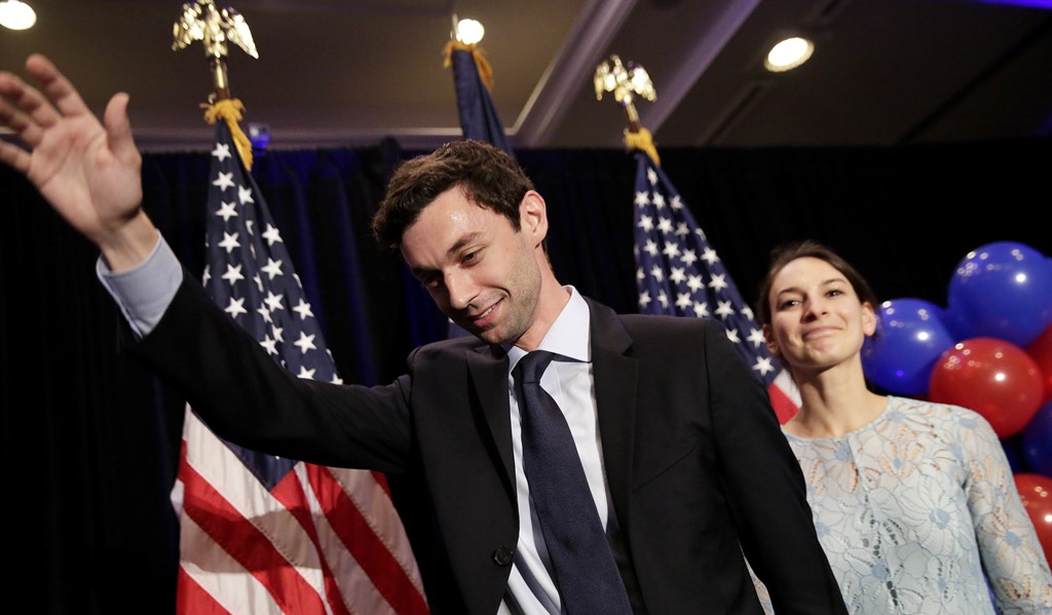What did Democrats learn from last week’s special election in Georgia? Jon Ossoff, the man backed by Democrats around the country for Tom Price’s old House seat, offers lessons to his party — or at least, that’s how the Washington Post headlined his valediction. It doesn’t take long to get to Ossoff’s central lesson, which is a study in both denial and projection:
Here in Georgia, in a district considered safe for Republicans for decades, we built a grass-roots organization powered by thousands of volunteers and hundreds of thousands of small-dollar donors.
The right wing’s national apparatus fully mobilized to defend the status quo in Washington at any cost. I was defeated. But we put up a hell of a fight.
Grass-roots politics, linking small-dollar fundraising to massive local volunteer organization, showed that it can rival the power of a right-wing machine comprising super PACs backed by entrenched interests and mega-donors. These outside groups were forced to spend nearly $20 million defending a seat gerrymandered never to be competitive.
Ossoff made this same argument the day after the special election, claiming that his loss proved the need for campaign-finance reform. It’s nonsense on stilts, and the only reason Ossoff competed at all in this district was because of an avalanche of out-of-state funds into his coffers long before the GOP awoke to the threat. No one’s quite sure about the extent of the spending — the final reports have yet to be filed — but it’s a sure bet that it will have exceeded $50 million. The Atlanta Journal-Constitution notes the heavy spending by Ossoff on radio and TV, which dwarfed the efforts of Karen Handel:
The analysis shows Ossoff laid out $14.2 million on ad time and spent at least another $8 million on other costs. Handel spent $2.5 million on TV, radio and cable spots and had at least $1 million in other expenses.
Both campaigns were buoyed by a tide of outside spending in the runoff phase, though Ossoff’s record-breaking fundraising haul – he took in more than $23 million since January – meant he needed less backup.
Still, the Democratic Congressional Campaign Committee spent nearly $5 million on TV ads boosting his campaign or slamming Handel, while other left-leaning groups chipped in about $1 million more.
Republican outside groups spent a little more at roughly $9 million, but that hardly made up for the overwhelming money advantage Ossoff had. Where exactly did Ossoff raise all that money? It wasn’t in the district, or even in the state:
He reported 7,218 donations from the state of California and 808 donations from Georgia over the past two months, according to the Mercury News. Ossoff had over 3,000 donors in the San Francisco Bay area alone, nearly four times as many donors as he had in Georgia.
Overall, between March 29 and May 31, Ossoff reported $456,296.03 from California compared to $228,474.44 from Georgia. Ossoff received more than $220,000 from the Bay area alone. The Mercury News noted that the totals were only a fraction of the actual donations since he doesn’t have to report donations of less than $200.
This may have been a David-and-Goliath race, but if so, Ossoff wasn’t David. As for GA-06 being “gerrymandered,” well, here’s the map of the district (via Wikipedia Commons):

It’s hardly a “salamander” district, and its northwestern border was drawn along the Fulton-Cherokee county line. The map to the right shows that GA-06 is drawn in similar style as other Georgia districts, and doesn’t look all that atypical for suburban districts around the country. Democrats want to create a narrative that their failures are all due to gerrymandering, but this proves otherwise. GA-06 isn’t a safe Republican district because of gerrymandering; it’s safe because its voters are more Republican.
Ossoff’s claim of victimhood over campaign spending manifests chutzpah to the scale of performance art. Ossoff wouldn’t have competed at all had Democrats not had the opportunity to pour tens of millions of dollars into the district, and in the end, his loss showed that the money didn’t carry the day anyway. Ossoff lost because voters didn’t buy his centrist schtick, and that even a special-election turnout couldn’t be gamed enough by outside spending to gain a temporary win in a relatively safe Republican district.
And that points to the real lesson for Democrats, who should be asking themselves what they hoped to gain from their $30 million-or-so investment. Had Ossoff pulled out the win, they’d have had to spend a similar amount of money in 2018 to hold the seat, especially after Ossoff’s alignment with Nancy Pelosi progressives (as he made clear in his concessions speech) emerged. Rather than try to sucker voters into electing a phony centrist, perhaps they should spend a fraction of that money attempting to find actual centrists — and getting rid of the fossilized leadership that marginalizes the few successful centrists the Democrats have.








Join the conversation as a VIP Member